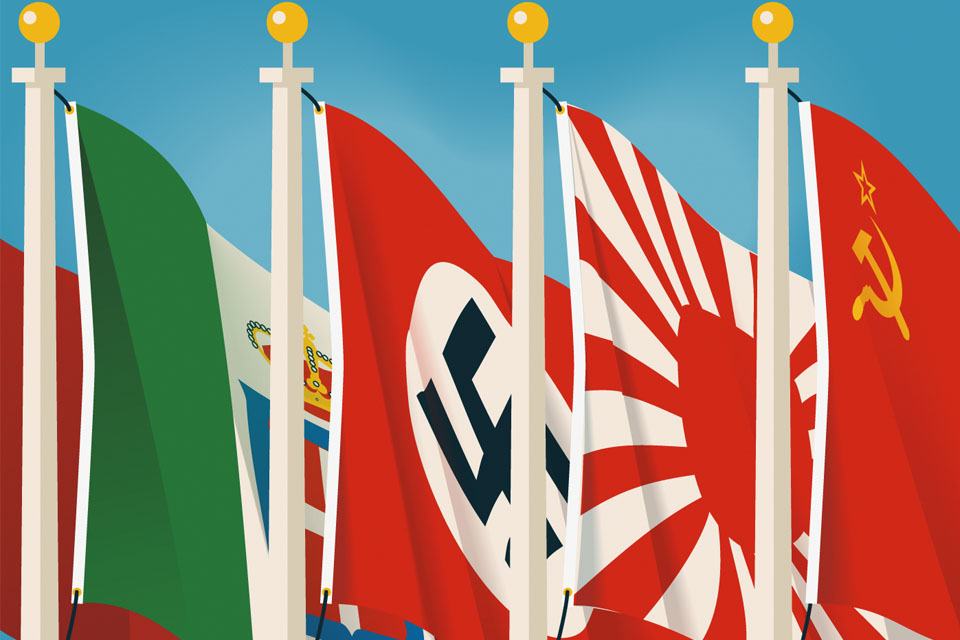[dropcap]S[/dropcap]uppose…”
The war often fascinates us less because of what happened than because of what might have happened, prompting some of us to dream up paths the conflict could have traveled, especially to victory for the Nazis. I admit: few such scenarios impress me. As I see it, change too many World War II variables, and pretty soon you’re in the Fantasy and Science Fiction aisle at Barnes & Noble.
Most alternate scenarios are operational. What if, in May 1940, Hitler doesn’t halt his Panzers short of Dunkirk? What if, in August 1941, the Wehrmacht, instead of wheeling south into Ukraine, keeps driving to Moscow?
Other propositions emphasize personnel. What if in February 1933 Giuseppe Zangara kills FDR? What if in 1924 Hitler falls down steps, or dies in a bus crash? These questions tickle the brain, but also take us pretty far afield. Without Hitler, for example, you probably don’t even have World War II.
But I do see one plausible scenario. First, the reality:
Consider Russia, and its revolutionary alter ego, the U.S.S.R. During World War I, France and Britain have the Russian Empire on their side, but in the 1920s, the Soviet Union makes nice with the Germans, for example allowing them to build a tank school at Kazan so the Germans can experiment with weapons the Treaty of Versailles banned. Distance sets in when Hitler comes to power. Unsettled by the German leader’s palaver, Soviet Vozhd, or “Boss,” Joseph Stalin tacks this way and that in foreign affairs. Hitler’s rabid chatter about eradicating Marxism, destroying the Soviet Union, and building a Teutonic empire in the east frightens Stalin. He at first leans toward blocking Germany through cooperation with the Western democracies. Significantly, Soviet Foreign Minister M. M. Litvinov has a British wife, Ivy, a factoid crucial to Kremlinologists reading the most obscure Soviet tea leaves.
The Soviets abruptly stop tilting west in 1939. By now, Hitler has launched multiple provocations—rearmament, Anschluss with Austria, the Czech crisis—but still the western powers try to appease him.
In response, Stalin concludes that Britain and France are willing to accept German expansion—provided it aims eastward. The Soviets have to see to their security. The Boss moves swiftly, ditching Litvinov for V. I. Molotov, a trusted member of his inner circle. The shift signals that Stalin is ready to negotiate with Hitler. Why? Because, unlike Litvinov, Molotov is not a Jew.
And so in August 1939 Germany and the U.S.S.R. sign a non-aggression pact and, in a secret “spheres agreement,” divvy up Eastern Europe. Hitler can attack Poland without worrying about Soviet interferrence.
However, without Russia, the western powers will be hard-pressed to beat Germany—as they prove in the war’s first two years. With Stalin sidelining himself, from 1939 into 1941 Hitler does the Blitzkrieg bop, his war machine sustained by raw materials the Soviets provide under the pact. But Hitler cannot not attack Russia any more than he can resist declaring war on the United States after Pearl Harbor, and he and the Reich ride Operation Barbarossa and the Axis alliance straight to hell.
So here is my alternate scenario. It’s big, but simple: in 1941, Hitler doesn’t invade the Soviet Union. Digesting his victories in Poland, the West, and the Balkans, he represses his yen for Lebensraum—“living space,” as he calls territory to be seized, emptied of occupants, and repopulated with German colonists—reasoning that he might have a good thing going as long as Russian tribute enriches his regime. He piles a few more divisions into North Africa, builds more planes and U-boats, consolidates his grip on Fortress Europe. All sorts of strategic vistas open. And Stalin, terrified of war with Germany, continues to ship Soviet resources west.
What results? A German-inflected world. Europe is a Reich plantation with gerrymandered borders, smash-and-grab trade policies designed to favor Berlin, and new place names galore: Hitlerburg, Hitlerberg, Hitlerstadt, etc.
Two superblocs—a totalitarian “Axis-plus” of Germany, the U.S.S.R., Japan, and Italy, and a “NATO-minus” of the United States and Britain—dominate. The U.S. is an industrial giant, of course, but so is Germany, as is the U.S.S.R., whose economy is intact. Stalin wants to keep it that way, and—as in 1939—will do anything to avoid a war with Germany. He knows he’s riding the tiger.
It is an ugly world, too: permanent wartime economies, low standards of living, militarized societies of uniforms and flags, Hitlerian racial policies. Lend-Lease keeps Britain fighting, barely, but with isolationism ascendant in the U.S., Britain faces a long, even permanent war. And such wars aren’t good for democracy or free speech. The West is unconquered, but less free.
You might say expecting Hitler to be reasonable is, well, unreasonable. But he has displayed reasonableness in the past. Yes, he has been promising for years to exterminate the Soviets, but he was saying so no less in 1939—when he signed a treaty with them—than in 1941, when he unleashes Barbarossa.
You want a different war? Do not invade the U.S.S.R. World War II changed the moment the first German boot touched Soviet ground. For Hitler, breaking up with the Boss and launching Operation Barbarossa in 1941 was a war of choice: a very bad choice.
Originally published in the May/June 2016 issue of World War II magazine. Subscribe here.





